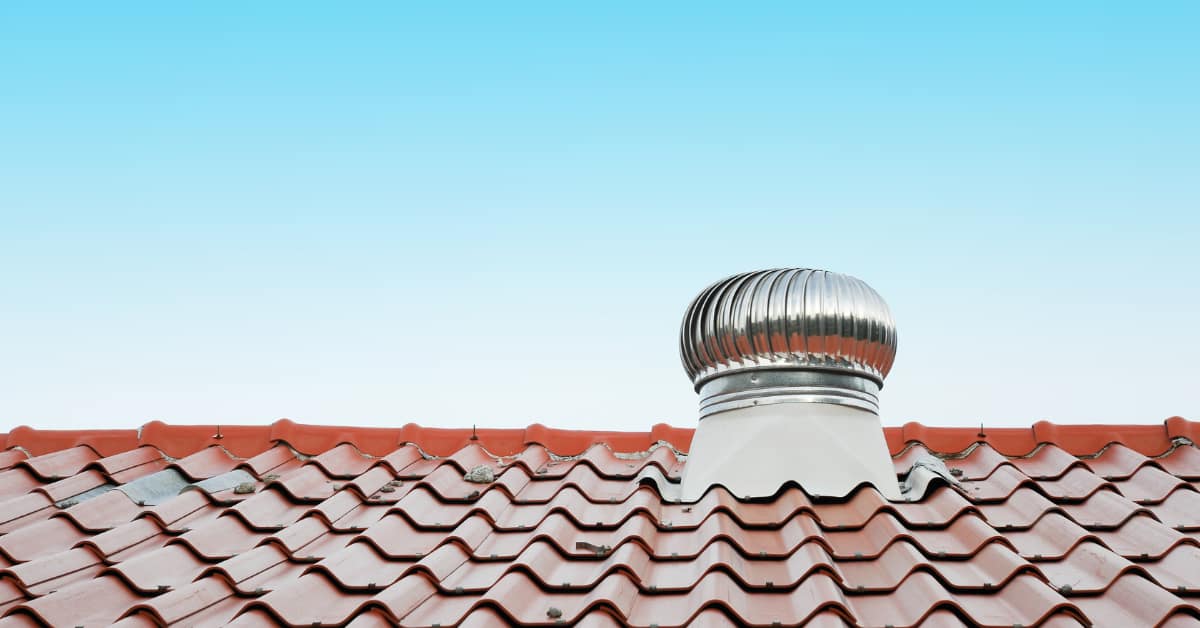Lots of sunlight and plenty of rain means Texas attics can easily become sweltering and humid environments—perfect for mold and wood rot. Not only can this cause structural damage, which opens the door for bigger problems like roof leaks, but a poorly ventilated attic can also increase energy costs throughout the year.
What’s the solution? Airflow. But there’s more than one way to achieve it. A well-designed roof ventilation system just needs to let fresh air flow into the attic while expelling excess heat and humidity. In other words, roof ventilation should matter a lot to homeowners—even if it isn’t always top of mind. That’s why, in this guide, we’re going to take a closer look at the type of roof vents and what can go wrong if ventilation is inadequate.
Types of Roof Vents
There are several types of roof vents, each with their own specialized method of maintaining airflow. Ultimately, roof ventilation is based on the fact that warm air rises, so if fresh air can enter the attic near the soffits and hot air can exit the attic near the ridge, the conditions in the attic will improve. In other words, proper airflow will come from having vents in lower and higher locations on the roof. With this in mind, let’s take a look at a few major types of vents.
Static Vents
Static vents are simple openings that let hot air escape from the attic without using any moving parts. This is called “passive” ventilation—that is, ventilation that doesn’t rely on fans or turbines. If soffit vents are pulling in cooler air, then warmer air should be able to passively exit through these vents. Due to their simplicity, these vents are easy to maintain, but the level of airflow they provide will depend entirely on natural airflow. This could become a problem if you have a lot of hot, humid, windless days.
For instance, a common type of static vent is a ridge vent, which runs along the highest point of the roof, allowing warm air to escape evenly across the attic. Since they run the entire length of the ridge, they let hot air uniformly escape, preventing “hot spots” and moisture buildup in corners or between vents. As mentioned earlier, ridge vents work best when combined with soffit vents, creating continuous airflow that naturally cools the attic. Without moving parts or complicated components, ridge vents are an affordable and low-maintenance roof ventilation option.
Turbine Vents
Turbine vents, also called whirlybirds, use wind power to spin and pull hot air out of the attic. This can improve airflow through the attic, but the turbine feature still requires consistent wind outside. Turbine vents are an affordable way to improve air circulation, and while they do require occasional maintenance to keep them spinning smoothly, it’s nothing expensive or complicated. Investing in external brackets (as opposed to internal brackets) will ensure your turbine vents are easier to adjust and less likely to break. However, just like static vents, adequate airflow isn’t guaranteed if you have a lot of calm or windless days.
Gooseneck Vents
There’s another kind of vent you might see on a roof—and it doesn’t have anything to do with attic circulation. Gooseneck vents are designed for specific uses, such as venting kitchen exhaust fans or bathroom vents. They have a curved, protective shape that prevents rain from entering while still allowing airflow. Many models will include wire mesh covering to make sure pests and debris can’t get inside, as well as a built-in damper that opens only when in use.
Effects of Improper Venting
But why is ventilation so important? It isn’t just about a higher energy bill. Here are some of the other big risks of improper roof ventilation:
- Premature Shingle Damage: Heat and UV rays can seriously deteriorate asphalt shingles. Mix that with excessive attic heat, and you’ll start to see curling, cracking, and wear across your roof covering. This leaves vulnerable underlying structures open to the elements, causing bigger problems. Without addressing the ventilation issue, you’ll also have a lot more shingle maintenance and replacement in the future. A good roof ventilation system will keep your attic and shingles cooler, extending the life of the roof.
- Mold and Wood Rot: Without proper airflow, attics will trap moisture and heat, leading to mold and mildew that can spread across internal support structures and weaken them. Over time, this can lead to serious damage. More than that, houses aren’t hermetically sealed—some of the steam from that long shower can make its way into the ceiling and roof, adding to the moisture problem. Good attic airflow will expel this moisture before it can cause damage.
- Ice Dams: If your attic gets warm enough to melt snow on the roof, it’s often cool enough to freeze it along the eaves. This can create an ice dam as water flows down the roof, refreezes along the eaves, and increasingly puddles and refreezes. This can cause serious damage to your shingles.
We’re Here to Help
Need an expert opinion? Don’t hesitate to contact the DFW Roofer team with your questions about choosing the right roof. Call us at (469) 751-4018 or schedule an appointment through our online appointment form.


